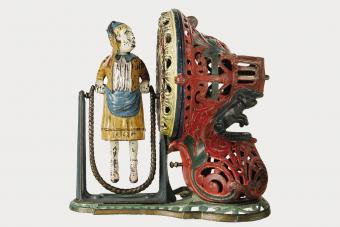
From 18th century automatons that could write a full letter to the player pianos featured in every saloon, mechanical inventions have fascinated us for centuries. Yet the smallest pieces can garner the biggest interest. Antique mechanical coin banks broke onto the scene just a few years after the Civil War and are one of the most valuable cast iron collectibles from the era. After all, your modern piggy banks have got nothing on these extremely valuable financial toys.
That Time America Fell in Love With Mechanical Coin Banks
According to famed antiques appraiser Dr. Lori, the first American mechanical coin bank broke onto the scene in 1869. It took very little time for artists to realize how much potential there was with these cast iron inventions. Throughout the Gilded Age, these toys were massively popular, and what's resulted is a vast array of them scattered across antique stores and personal collections.
What Exactly Is a Mechanical Coin Bank?

Mechanical coin banks are cast iron receptacles made to store your loose change. Their distinctive feature was that they had a spring-loaded sequence of movements that was triggered when you dropped your coin into the designated slot.
If you could wire a few levers and springs to the set-up, you could effectively bring any motion-driven scene to life. A few examples of the types of scenes you might find include:
- A boy dropping the coin into a pig's mouth.
- Presidents shooting wild animals.
- Kids stealing fruit off a tree branch.
- People riding a carousel.
Antique Mechanical Coin Bank Manufacturers
Just like many pottery and ceramic makers, cast iron coin banks were made through large manufacturers but designed by multiple different people contracted to the same company. So, while there are too many designers to count, there are a number of manufacturer's names to be on the lookout for:
- J. & E. Stevens
- Kyser & Rex
- Mechanical Novelty Works
- Shepard Hardware Co.
How Their Subjects Reflected Current Events and Cultural Beliefs

Interestingly, antique mechanical coin banks from the late-19th century offer a unique insight into so many arenas of daily American life. The subjects that were highlighted in these banks worked in tandem with newspaper headlines, political cartoons, and cultural movements to reflect them in moving pieces.
However, for all the harmless President Teddy Roosevelt caricatures, there were just as many racist stereotyped banks being sold. While these coin banks do hold high value on the resell market, we have to acknowledge that a large portion of these were inherently created under a white supremacist culture. After all, the country wasn't five years outside of the Civil War, and the Jim Crow era, combined with growing anti-immigrant legislation, was just on the horizon.
How Valuable Are Antique Mechanical Coin Banks?
Antique mechanical coin banks are some of those antiques where they look old enough to be worth something, and they actually are. Nineteenth century cast iron mechanical coin banks are worth thousands of dollars at auction. Naturally, with something worth so much money, you have to look out for copycats. These don't have the same smooth texture that genuine antique cast iron does. Similarly, in Dr. Lori's experience, any that've been repainted in acrylic are worth less than those with little paint remaining.
Generally, coin banks from one of the major manufacturers (J.&E. Stevens and Kyers & Rex) in great condition (paint mostly preserved, mechanics still working, few replacement parts present, etc.) will sell for upwards of $10,000. For example, these two coin banks were both made in 1880, and both sold for $10,755. Yet, J.&E. Stevens' dentist scene couldn't be less similar to Kyser & Rex's Merry-Go-Round. This just shows that subject matter isn't really the driving factor for mechanical coin bank values.
Collectors will still buy less preserved and unmarked coin banks, but they'll do it at lower prices. For example, this classic Paddy and Pig coin bank from 1882 only sold for $680. Even Teddy Roosevelt's visage isn't enough to bring in tens of thousands. This 1907 Teddy Roosevelt coin bank that's in fair condition only sold for $1,212.
What to Look for in Old Mechanical Coin Banks

If you're not sure what you're looking at or want to estimate its value a little easier, take stock of the coin bank using these quick assessment points:
- Does it have a coin slot? The coins have to go somewhere and if it doesn't have a coin slot, then it's probably not a coin bank.
- Is it heavy and smooth? Most antique mechanical coin banks were made out of cast iron and are heavy and smooth as a result.
- Is it painted? Most coin banks were painted as an artistic measure, and the more original paint that's left, the more the bank can be worth.
- Is it marked? Look on the bottom, back, and sides for a manufacturer's name or mark. Unmarked ones don't sell for nearly as high amounts as marked ones.
Toss a Coin to Your Antique Mechanical Coin Bank
If you're someone interested in weird history and tchotchkes, then antique mechanical coin banks are right up your alley. They're quirky, have slightly off-putting designs, and can be worth a ton of money. And, with cast iron's reputation for lasting a lifetime, these bad boys are here to stay.







